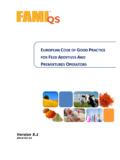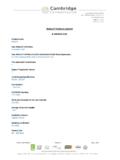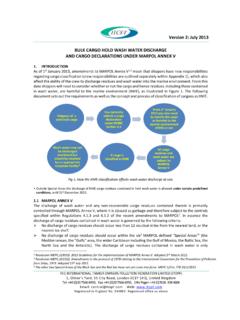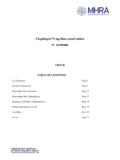Transcription of TABLE OF CONTENT - fefac.eu
1 European Feed Manufacturers Guide (EFMC) Community guide to good practice for the EU industrial compound feed and premixture manufacturing sector for food producing animals Version November 2014 1 TABLE OF CONTENT 0. INTRODUCTION ..3 1. SCOPE AND DEFINITIONS ..5 Scope .. 5 Legal Definitions .. 5 Other Definitions .. 7 2. FEED SAFETY MANAGEMENT SYSTEM .. 10 General Requirements .. 10 Risk Analysis and HACCP (see Annex I on the application of the HACCP principles) .. 10 Management Responsibilities .. 10 Feed Safety Management Structure .. 10 Training .. 11 External Communication with feed chain partners .. 11 Traceability, Record Keeping and Product Recall .. 12 General Requirements .. 12 Product Traceability Records .. 12 Documentation 13 Incoming Feed Sourcing .. 13 End Product Specifications .. 14 Record Keeping .. 14 Control Plan .. 14 Internal Audits.
2 15 Non-conforming Feed and Product Recall .. 16 Complaints Procedure in Relation to Safety .. 16 Inspection, Sampling and Analysis (monitoring) .. 16 Physical Inspection .. 17 Sampling .. 17 Sampling frequency for monitoring .. 17 Analysis .. 18 European Feed Manufacturers Guide (EFMC) Community guide to good practice for the EU industrial compound feed and premixture manufacturing sector for food producing animals Version November 2014 2 3. good HYGIENE practices .. 19 General Requirements .. 19 Control of Contaminants and Carry-over .. 19 19 Undesirable Substances and Products / Biological Hazards / Negative List .. 19 Additives .. 21 Plant Design and Maintenance / Personal Hygiene .. 21 Building construction and layout .. 21 Storage, Production Facilities and Manufacturing Equipment .. 22 Planned Maintenance .. 24 Personal Hygiene .. 25 Purchase, Delivery, Intake of Incoming Feed.
3 25 Purchase .. 25 Specifications of Feed Materials, Feed Additives and Premixtures .. 25 Delivery, Intake and Storage of Incoming Feed .. 26 Manufacturing Process, Storage and Delivery of compound Feed and Premixtures .. 26 Manufacturing .. 26 Storage of finished feed .. 30 Transport and Delivery .. 31 Product Traceability 32 Incoming Feed .. 32 Finished Feed .. 33 Delivery .. 33 4. REFERENCE DOCUMENTS .. 34 EU Food and Feed Legislation (non-exhaustive list) .. 34 International Standards .. 34 ANNEX I: GUIDANCE FOR THE APPLICATION OF HACCP PRINCIPLES .. 34 ANNEX II: SPECIFIC REQUIREMENTS FOR MEDICATED FEED .. 50 ANNEX III : GUIDANCE FOR THE IMPLEMENTATION OF CERTAIN SECTIONS OF THE EFMC .. 58 ANNEX IV: LIST OF NATIONAL FEED MANUFACTURERS GUIDES .. 66 ANNEX V: LIST OF REPRESENTATIVES OF EUROPEAN FEED BUSINESS SECTORS .. 67 European Feed Manufacturers Guide (EFMC) Community guide to good practice for the EU industrial compound feed and premixture manufacturing sector for food producing animals Version November 2014 3 0.
4 INTRODUCTION The industrial compound feed sector is a significant link in the production chain of food products from animal origin. Producing safe feed and food products is first and foremost a question of good management practices at each stage of the feed and food chain from primary production to final processing. It is, therefore, the responsibility of each operator in the feed and food chain to comply with all relevant current food and feed safety requirements, to implement good practices to ensure the safety of the goods he produces and to meet customers requirements. In parallel with the development of the EU feed legislation, which mainly focused on food safety objectives, the EU compound feed industry has developed feed safety assurance systems laying down a number of requirements to support the proper implementation of the feed and food safety standards and establishing its own standards where required.
5 These feed safety assurance systems have been developed either individually or collectively at national level. Since 1998, FEFAC has established guidelines for the development of national guides to good practice for the manufacturing of compound feed and premixtures in order to foster the practical implementation of good hygiene practices and to achieve a common technical ground for the development of feed safety assurance systems. Regulation (EC) No 183/2005 on feed hygiene acknowledges the positive contribution of good hygiene practices to achieve the objectives laid down in the EU feed safety legislation and encourages the development of national or Community guides to good practice by feed business sectors, in consultation with any interested party. The FEFAC guidelines were adapted to meet the requirements of the Feed Hygiene Regulation and were renamed as the European Feed Manufacturers Guide (EFMC).
6 The main objective of the EFMC is to help ensure the safety of feed for food producing animals and of food stemming from those animals and designed for human consumption through implementation of good Manufacturing Practice during the purchase, handling, storage, processing and distribution of compound feed for food producing animals in accordance with the objectives of the CODEX Code of Practice on good Animal Feeding and the requirements laid down in the EU General Food Law (Regulation (EC) No 178/2002), in particular Article 17. The guidance document1 on the implementation of the General Food Law approved by the Standing Committee on the Food Chain and Animal Health at its meeting of 20 December 2004 must be regarded as an essential document that operators should refer to for compliance with the General Food Law Principles.
7 From 2002 on, FEFAC organised annual meetings with other partners of the chain listed in Annex V of the Guide. The purpose of these meetings was to involve our chain partners at an early stage of the development of the EFMC and also to discuss the development of guides to good practice in the feed chain at large. A formal consultation, extended to EU organisations of consumers, retailers and modern restaurants was launched in July 2004 with a view to prepare the adoption of the final draft EFMC by the FEFAC Council. The outcome of this formal consultation was considered at a stakeholders workshop on 20 October 2004. The comments exclusively focused on provisions regarding the sourcing of feed materials, provisions that are no longer mentioned in the present guide. The final draft EFMC was notified to the EU Commission in accordance with Article 22 of Regulation (EC) No 183/2005 and then further amended to take into account the comments and requests of the Standing Committee on the Food Chain and Animal Health.
8 It was once more assessed by the Standing Committee on the Food Chain and Animal Health at its meeting on 29 January 2007. The title European Feed Manufacturers Guide (EFMC): a Community Guide to good Practice for the Industrial EU compound Feed and Premixture Manufacturing Sector for Food Producing Animals and the references of the EFMC were published in the OJEC No C64 of 20 March 2007, page 17. 1 The document is available at the following link: European Feed Manufacturers Guide (EFMC) Community guide to good practice for the EU industrial compound feed and premixture manufacturing sector for food producing animals Version November 2014 4 A special Committee, the so-called Feed Safety Management Committee, was established within FEFAC to review, on a regular basis and at least once a year, the European Feed Manufacturers Guide against any new development in the technological, scientific, normative and legislative area and, if needed, to proceed to necessary adjustments, in consultation with other interested parties.
9 The draft updated versions of the guide will be notified to the EU Commission for assessment. With a view to ensuring that the coexistence of nationally developed guides to good practice does not result in undesirable barriers to trade within the EU, the present EFMC is also designed to provide practical information for the benchmarking of national guides to good practice for the production of safe compound feed and premixtures in order to facilitate the mutual recognition of these existing national guides to good practice by the public authorities, national guides owners and stakeholders in the feed and food chain. The EFMC may also be used as a reference document for the development of feed safety assurance systems. In this case, the development of certification rules is the responsibility of the national scheme owners and should be based on EN 45011.
10 Medicated feed is a specific form of compound feed, which is often produced in the same plant as conventional compound feed. Therefore, the manufacturing, storage and delivery have to comply with EU legal feed hygiene requirements as laid down in Regulation (EC) No 183/2005. This is why any EFMC provision pertinent for conventional compound feed is also pertinent for medicated feed. In addition, medicated feed is subject to specific EU legislation, Directive 90/167/EEC, which provides for additional hygiene and safety practices . Considering the differences in terms of implementation of this Directive at national level, it was decided to include these additional requirements in a separate Annex II. However, any national good practices developed in accordance with article 4(d) of Directive 90/167/EEC may take precedence over the present good practices laid down hereafter. The EFMC only covers safety related issues, the safety of feed for animals to ensure human as well as animal health.






